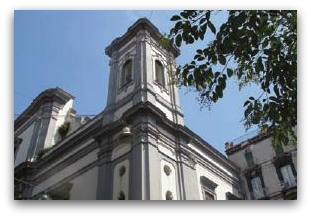
- San Giorgio Maggiore
The principal entry of the church is in Crocelle ai Mannesi and presents the ancient paleo-Christian apse formed by a semidome on three arcs planned on two columns, with Corinthian capitals and a pulvinus adorned with a Latin-Greek cross.The Church was supposed to be the Episcopalian center of the oriental rite that was present in Naples together with the Latin rite that had the Episcopalian center in Saint Stefania, now Cathedral in Naples.
Remade in the XVIII century by Cosimo Fanzago, presents only two of the original three aisles, because of the destruction of the right aisle following the amplification of Via Duomo in the XIX century. The coverage is constituted by three domes. On the side altars can be admired works by Francesco Peresi (1713), a Francesco Solimena's pupil, while in proximity of the side entry, in Via Duomo, there is the Cathedral of San Severo.
On the opposite side, there is the pulpit, rehandled during the centuries, that presents a tondo representing a Madonna with her child, presumed work by Diego De Siloe.
In the presbytery there is a wooden crucifix of the XII century, while the altar (1786), at the hands of Camillo Lionti, presents the female representations of the Oration and the Church, works of the sculptor Angelo Lives. Behind the altar, the relics of St. Severe are preserved.
In the apse two canvases are admired, of great dimensions, by Alessio d' Elia, an other Solimena's pupil, representing St Severo and St. George. The scene of Saint George Killing the Drag is of great importance. In the third chapel of the left aisle there is a triptych frescoed by Francesco Solimena. The ancient sacristy preserves, besides, paintings of the XVII and XVIII century.